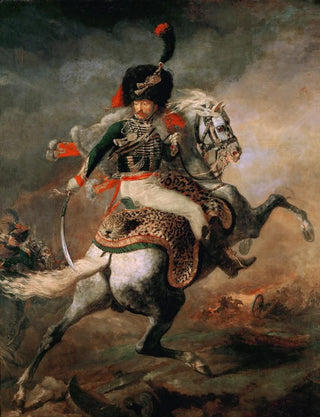Art print | The Charging Chasseur - Théodore Géricault Source: Reproduction | The Charging Chasseur - Théodore Géricault


View from behind

Frame (optional)
In the vibrant world of Romantic painting, the art print "The Charging Chasseur" by Théodore Géricault stands out for its narrative power and emotional intensity. This iconic canvas, created in 1812, captures the warrior spirit and heroic momentum of a rider in full charge, a moment suspended between action and contemplation. Through this work, Géricault does not merely depict a soldier; he evokes an ideal of bravery and sacrifice, embodying the aspirations of an era marked by the tumult of the Napoleonic wars. The scene, both dynamic and rich in symbolism, invites the viewer to feel the adrenaline of combat while reflecting on the human condition in the face of violence.
Style and uniqueness of the work
Géricault's style in "The Charging Chasseur" is a bold fusion of realism and romanticism. The energetic brushstrokes and vivid color palette demonstrate the artist's technical mastery, while infusing the scene with an almost palpable life. The hunter, the central figure of the composition, is depicted in a dynamic movement, with his posture and expression conveying unwavering determination. The meticulous details of his uniform, contrasting with the blurriness of the background, create a visual depth that draws the eye and maintains focus. This art print is not only a celebration of military courage but also a reflection on the fragility of life, a theme dear to Géricault, who knows how to capture the very essence of heroism while not forgetting the shadows that accompany it.
The artist and his influence
Théodore Géricault, an emblematic figure of the Romantic movement, left a lasting mark on art history through his innovative approach and unique sensitivity. Born in 1791, he established himself as one of the pioneers of modern painting, influencing generations of artists. His work, rich in emotion and reflections on the human condition, stands out for its commitment to subjects often overlooked by his contemporaries. "The Charging Chasseur" is part of this desire to transcend mere decoration to

Matte finish

View from behind

Frame (optional)
In the vibrant world of Romantic painting, the art print "The Charging Chasseur" by Théodore Géricault stands out for its narrative power and emotional intensity. This iconic canvas, created in 1812, captures the warrior spirit and heroic momentum of a rider in full charge, a moment suspended between action and contemplation. Through this work, Géricault does not merely depict a soldier; he evokes an ideal of bravery and sacrifice, embodying the aspirations of an era marked by the tumult of the Napoleonic wars. The scene, both dynamic and rich in symbolism, invites the viewer to feel the adrenaline of combat while reflecting on the human condition in the face of violence.
Style and uniqueness of the work
Géricault's style in "The Charging Chasseur" is a bold fusion of realism and romanticism. The energetic brushstrokes and vivid color palette demonstrate the artist's technical mastery, while infusing the scene with an almost palpable life. The hunter, the central figure of the composition, is depicted in a dynamic movement, with his posture and expression conveying unwavering determination. The meticulous details of his uniform, contrasting with the blurriness of the background, create a visual depth that draws the eye and maintains focus. This art print is not only a celebration of military courage but also a reflection on the fragility of life, a theme dear to Géricault, who knows how to capture the very essence of heroism while not forgetting the shadows that accompany it.
The artist and his influence
Théodore Géricault, an emblematic figure of the Romantic movement, left a lasting mark on art history through his innovative approach and unique sensitivity. Born in 1791, he established himself as one of the pioneers of modern painting, influencing generations of artists. His work, rich in emotion and reflections on the human condition, stands out for its commitment to subjects often overlooked by his contemporaries. "The Charging Chasseur" is part of this desire to transcend mere decoration to






